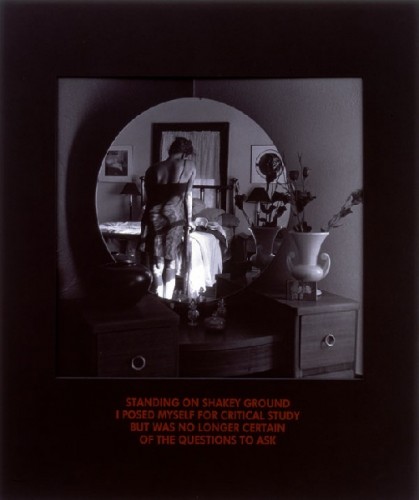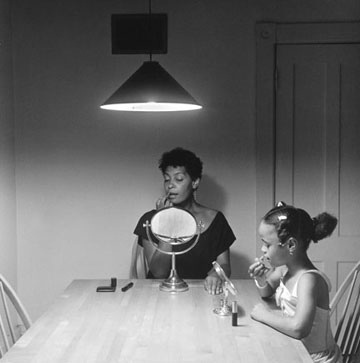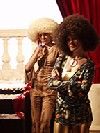Carrie Mae Weems at W. E. B. Du Bois Institute
All About an All-New Eve
By: Shawn Hill - Nov 18, 2007
Carrie Mae Weems
"All About Eve: Women, Sex & Desire"
Neil L. and Angelica Zander Rudenstine Gallery
W. E. B. Du Bois Institute for African and African American Research
Harvard University, 104 Mt. Auburn Street, 3R, Cambridge.
on view through January 3, 2008
http://www.dubois.fas.harvard.edu/
What's compelling about photographer Carrie Mae Weems' vision is how she explores themes of race and gender through the language of art history. In her new work "All About Eve" she casts herself as the artist's muse (the role of the artist is played by neo-expressionist painter Robert Colescott), and ponders the roles both she and the artist fall into, as if by destiny, despite designs to the contrary. Weems conflates very direct, often symmetrically composed black and white images with a few simple, poignant phrases or words. Her photographs are usually square in format, and not exceptionally large. But they pack a punch.
In a more introspective elaboration on the series, Weems views herself in her bedroom, seen indirectly by means of her vanity table mirror. Props and objects on the table and on the bed change from image to image, and the words tell the story of her desires. She imagines herself in each image as the muse of different artist, finding herself unable to satisfy Picasso; nonplussed by a disinterested Duchamp; and quite grateful to have avoided the attentions of de Kooning. In both series, subtle changes of pose and stance (sprawled on the bed, cornered by Colescott, nude as she is beingcontemplated and contemplates herself) suggest feelings unexpressed and tensions unresolved.
The show serves as a mini-retrospective for Weems evolution, including two early series (the "Kitchen Table" and "Sea Islands" photographs) and her most recent foray into video art "Italian Dreams." "Sea Islands" are rescue attempts; she looks back at historical photos of slaves, and makes them literally "colored" by tinting the monochrome images in blue, red or gold. The words that define the subjects – "field" "house" "yard" "kitchen" – have pointed connotations. These images were contemporary attempts to scientifically separate and classify by race. Weems is searching for the personalities ignored by those initial investigators and labelers.
The "Kitchen Table" works remain her most powerful mix of words and imagery. Each takes place around the same table with an interrogating light hanging overhead. Weems stares out at us from the head of the table or contemplates her lover as they smoke or drink. In one image she applies makeup with young girls looking in mirrors. In others she listens as he talks with a photo of Malcolm X on the wall behind her. The lengthy texts accompanying these works identify the power dynamics in African American heterosexual couples, especially bringing attention to black male identity insecurities, fears, and frustrations. The ways in which race and gender complicate intimate relationships are evocatively expressed by this work that at least finds the right questions, if not any answers.
If we look chronologically we see Weems moving closer to art itself as a theme and moving, to some degree, beyond broad concerns of race and gender towards a more personal exploration of her own identity as both artist and muse. The video seems especially concerned with self-presentation, including costumes and makeup that crosses racial boundaries and fashions that reflect a multi-ethnic world of possibility. Is Eve the best metaphor for this newly expressed persona? Only if it's not the Eve we know so well, the fallen temptress, but some altogether more complicated and multi-faceted woman.



